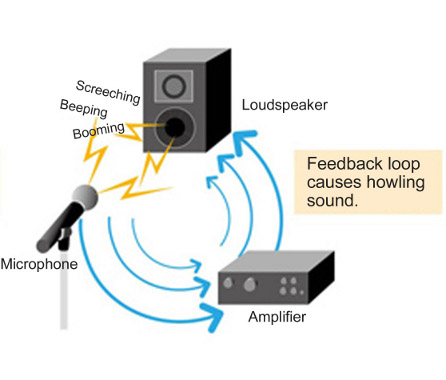Sound travels through air in the form of waves of pressure variations. It is a phenomenon of compression and expansion of air molecules. This wave of pressure variations could be drawn as a sine wave. The physical measurable length of one of this wave is called as wave length. This wave length differs for each frequency of wave. 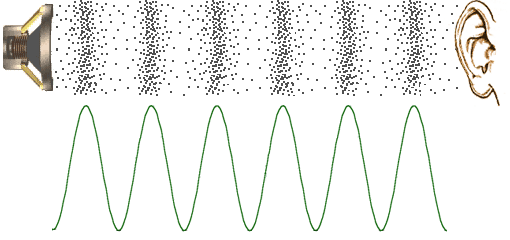
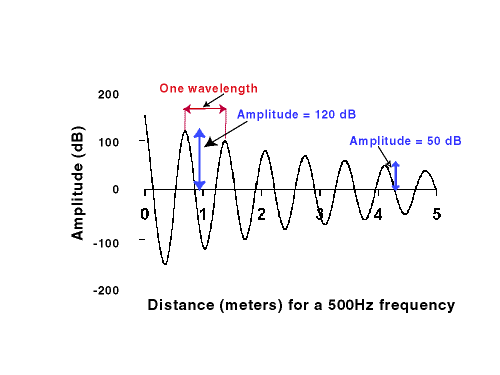
The frequency of a sound wave indicates the rate of pressure variations called as cycles. One cycle is a set of high pressure to low pressure and back to high pressure. The number of such cycles per second is called Hertz which is a unit of measuring frequencies.
Wavelength of sound = speed of sound / frequency –OR– Wavelength of sound = 1,130 feet per second / frequency
A microphone whose output is equal (no boost / no cut) at all frequencies has a flat frequency response. It is true to its source. A microphone that has peaks and dips in certain frequencies is said to have shaped response. Such microphones color (flavor) the original sound.
The pressure out in the field or in a room is called Atmospheric Pressure of that place. The change in air pressure above and below this normal atmospheric pressure is what human ear perceives as sound. This is also called Amplitude and is measured in Decibels (dB). The greater the difference between atmospheric pressure and pressure created by sound source, louder the sound. Sound cannot travel in vacuum as there is no medium (air) for it to propagate. Sound does travel through water but to a much lesser degree.
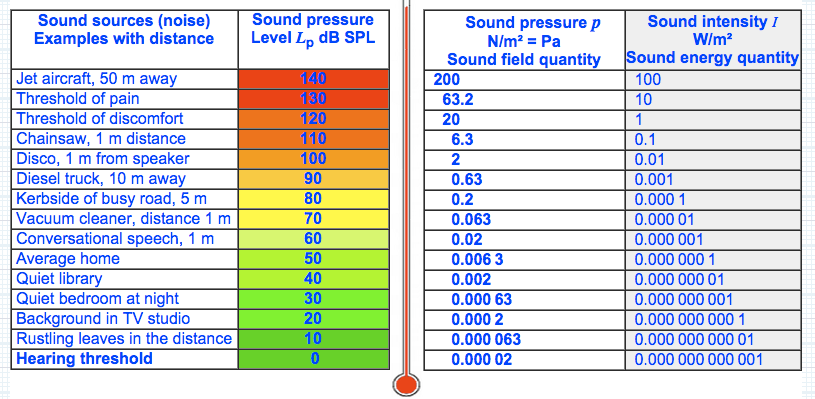
Sound Propagation
When sound travels through air it changes as a result of reflection, absorption, diffraction and refraction.
Reflection – A sound wave can be reflected by a hard surface or object if the surface or object is physically as large or larger than the wavelength of the sound. Low frequency sounds have long wavelengths hence can only be reflected by large objects. Higher frequencies which have smaller wave length can be reflected by smaller and large objects or surfaces. The reflected sound will have a different frequency characteristic than the direct sound if all frequencies are not reflected equally.
Absorption – We configure the PA system in a Masjid after carpet has been laid out and it is full of people. Without it the Masjid will have completely different acoustic characteristics. It will have lot of echo and reverb. Human beings, thick clothes that we wear, carpet etc all absorb high frequency sound. For low frequency absorption you need soothing heavy that can act as bass traps. Thick drapes can help, but we never do anything about it in any Masjid unfortunately.
One of the little known reasons why earlier Muslims used marble to construct Masajid is because of its sound absorption/dispersion/reflection characteristics. Marble is hard and porous. It reflects the high frequencies and absorbs the low frequencies (if present) which is exactly what we in sound engineering strive for. Human voice has very little bass (less than 150 Hz) if at all present. Even today some of the stone built masajid do not need any sound system because the natural acoustics are more than enough to take sound everywhere. Only ALLAH can give you exactly what you need.
Diffraction – A sound wave will bend around objects in its path if they are smaller than its wavelength. Low frequency sound wave is much longer and hence it bends around lot of objects and is harder to contain. High frequencies can be blocked easily and you can direct them easily to certain area. Sound engineers struggle with low frequencies as they lack direction and are virtually omni directional.
Refraction – This is atmospheric effect of wind and temperature felt outdoors when sound travels at large distances from loudspeakers. Sound bends because of these factors. Air from ceiling fans does not have much effect on sound. But huge fans have their own noise and cancel sound a lot making speech very difficult to understand.
Direct vs. Indirect (Ambient) Sound
Direct sound becomes weaker as it travels further from source. This decrease is measured by inverse-square law which states that the level change is inversely proportional to the square of the distance change. With doubling of distance, sound decreases by 6 dB which is very noticeable. The aim when installing a PA system in a Masjid is to keep the sound level at all places within a variance of 3dB. Human ear can distinguish a difference of 1dB, if the change is 3dB it gets noticed clearly, if the change is 6dB everyone will say why has the sound decreased / increased so much. A 10dB difference is perceived as double or half of the original sound level. A 20dB difference is perceived as a four fold change.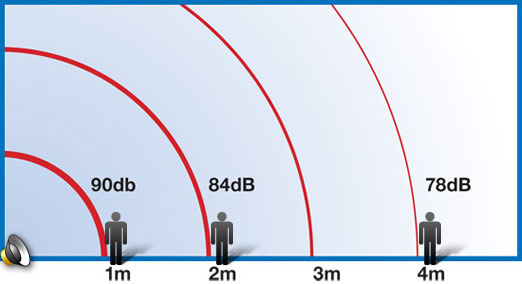
We have seen above that sound gets reflected on various surfaces when it is traveling through air. The result is a reflected sound. Most of the sound we hear is reflected sound unless you are sitting close and right in front of the source. Reverberation is an example of reflected or non directional sound. In a room there is a distance between sound source and microphone where direct sound and reflected sound is the same in intensity. This is called Critical Distance. If the microphone is placed at critical distance from the source (your mouth) all you hear is room sound with lot of reverberation. It lacks clarity. This is why it is important to keep the microphone close to Imam’s mouth. Lot of people who lead prayers keep the microphone almost two feet away as it makes Ruku and Sujood easy. This is a bad practice. Use a lavalier or headset microphone instead if you cannot use a stand mounted microphone.
Phase
Two identical sound waves starting at the same point in time are called “in-phase” and will sum together to double the amplitude. Two identical sound waves with their starting point 180 degrees apart are “out of phase” and will cancel each other completely. As almost all sound waves are made up of several frequencies, they either get all doubled, cancel each other or are in an intermediate state. This is called interference and should be avoided.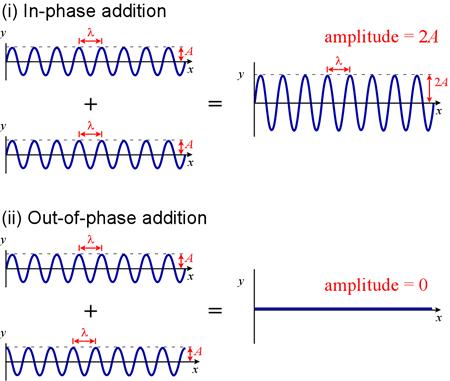
When a microphone is placed in such a way that the direct and reflected sound are in phase (like on a podium), then we see considerable increase in sound entering the microphone. Remember this increase is only for those frequencies that got reflected and not for the entire range. This concept of Phase is usually not an issue in Masajid as almost all of the sound getting into the microphone is direct sound from Imam’s mouth.
Comb Filter effect
This happens when Imam’s direct voice and reflected voice enters the microphone at different times. Another possible situation is when two microphones are used on the same stand and they are not equidistant from Imam’s mouth. The result is comb filter effect which is nothing but degraded frequency response. Easy solution is to remove reflective surfaces near Imam and use only one microphone to recite into.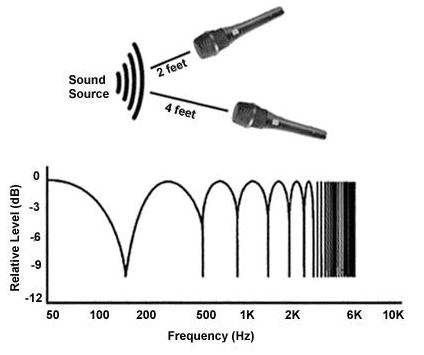
The 3-to-1 Rule
If you wish to use multiple microphones, follow the diagram below for omni directional microphones. This rule can be relaxed for directional and even more for Hypercardoid microphones. We never felt the need to use multiple microphones.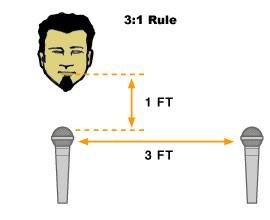
President Obama uses two modified Shure SM57 on podium and the Imam of Haram uses three microphones as backups. If one fails then the other(s) will capture the sound. Each microphone stand in Haram (Mecca) has 9 microphones, Three for Qiyaam (standing) position, 3 for Ruku and 3 for Sujood and they are all meant for backup purposes. If one fails other will still be working. They have several stands like these as backups too. Seven in total in the main white ground area which is at the same level as the Kabah.
Potential Acoustic Gain (PAG) vs Needed Acoustic Gain (NAG)
NAG is the amount of amplification needed so that the farthest listeners can hear the sound as if they were directly in front of performers. If the sound in the first row of jamaat is at 75dB and the last row is at 50dB, then we need to bridge this gap of 25dB using amplification. This 25dB is NAG. The maximum amplification is determined by the amplification level when the feedback starts to kick in.
PAG is the amount of amplification that can be squeezed out of the PA system before feedback kicks in. Ideally and usually PAG is greater than NAG so we have headroom to play with. It is the job of the sound engineer to maximize the PAG (also called Gain Before Feedback) by following some simple steps.
Keep microphones as close as possible to the Imam’s mouth without proximity effect kicking in, keep the speakers as far away as possible from the Imam (microphone) but as close to the congregation as possible, turn off ALL microphones not in use. Directional speakers and microphones will also improve the gain before feedback. Make sure speakers and microphones are not facing each other even partially. Other solutions which rarely need to be used include use of feedback suppressors and equalizers. These equipment reduce amplification of feedback causing frequencies within that space.
Both NAG and PAG can be calculated mathematically but it is beyond the scope of this discussion. The mathematical calculations are much simpler than you might think. But if you take care of the above mentioned points then you have already done what is needed without involving mathematics.
Feedback is caused by the infinite loop of sound from speakers entering microphone. It gets amplified more and more as the number of loops increase.